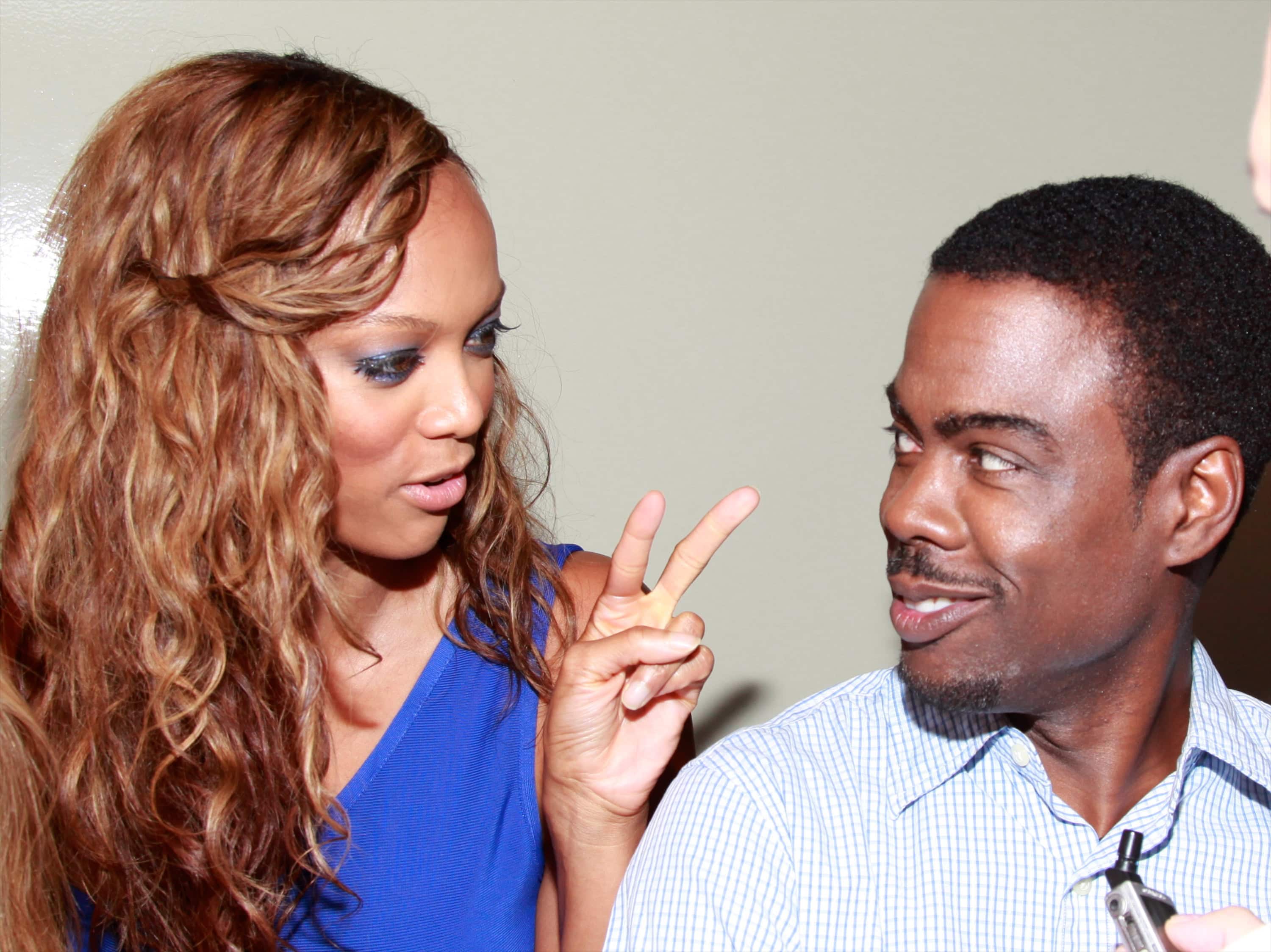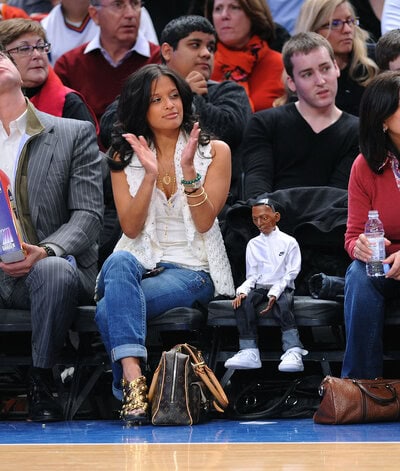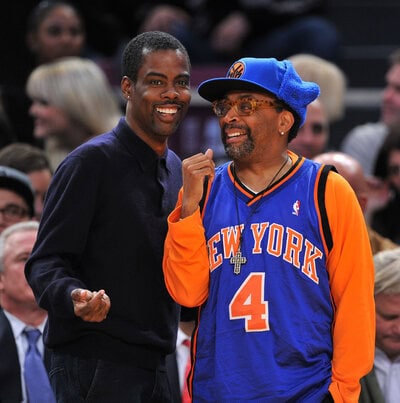Penny Hardaway. Nike. A puppet. A superstar guest list. An unscripted marriage proposal. The inside story of the most meta TV commercial concept that almost was.
25 years ago, a doorbell went off at Super Bowl parties that had hosts jumping off their sofas.
No, it wasn’t a late arrival. Sadly, it was neither delivery nor DiGiorno. Rather, it was a television commercial inviting 87 million viewers to a VIP party.
Answering the door, supermodel Tyra Banks greets guests at home as the televised gathering pans to a conversation between NBA All-Star Anfernee Hardaway and acclaimed director Spike Lee.
Soon, the real star enters the frame: Lil’ Penny, a knee-high doll voiced by Chris Rock.
For those keeping track at home, this wasn’t LP’s first party, but it was his biggest by far. A year prior, the pint-sized pitchman took over Big Penny’s crib while the Orlando Magic PG was on a road trip. The clip, which tied into Hardaway’s first signature sneaker, was the third commercial of its kind, perfectly juxtaposing the mild-mannered Memphis product with that of his jocular junior.
All told, Nike’s “House Party” ad was a banger — but it was only an appetizer.
Like LL Cool J before him, Lil’ Penny’s second effort would be bigger and deffer. For Super Bowl XXXI, Nike and Wieden + Kennedy went meta by portraying a Super Bowl party in a commercial that ran during the actual game. The guest list was absolutely unreal, pulling in a pre-Masters Tiger Woods and All-Pro Barry Sanders. However, it wasn’t all jocks, as six-year-old Jerry Maguire star Jonathan Lipnicki livened up the living room with Stevie Wonder.
Though a handful of attendees like Sergei Federov and Jackie Joyner-Kersee were already on Nike’s payroll, flying out and filling up the Orlando mansion that hosted the party had to be an enormous ask, right?
“Every Nike athlete wanted to be in it,” recalls Stacy Wall, the Wieden + Kennedy agency writer who created Lil’ Penny, in a conversation with Boardroom. “We were inundated with people who wanted to be at the party.”
Party On
Super Bowl XXXI took place on January 26, 1997 in New Orleans with an at-home audience glued to their televisions as Brett Favre’s Packers and Drew Bledsoe’s Patriots battled it out. Notably, Michigan Wolverine turned Packers gamebreaker Desmond Howard took a third-quarter kickoff to the house on his way to game MVP honors.
Miles away from the Superdome, Wall and the execs at Nike loaded a lush Orlando mansion with everyone from Michael Johnson to Jaleel White.
“Everyone they called didn’t turn it down,” Hardaway told Complex in 2016. “They knew how big Lil’ Penny was.”
With Wall writing and Rock snapping, the atmosphere was set for celebs to socialize and compete for camera time.
“It became a literal party, meaning we were running and gunning and shooting things as fast as we can,” Wall remembers. “It became a victim of its own success because every Nike athlete wanted to be in it — which was great! But we started to realize that to get to a 60-second edit might be a problem.”
Typically, the charm of Lil’ Penny commercials was making comedy out of small moments like watching a “Griffey for President” advertisement on the couch, or LP shooting his shot at Tyra Banks while sitting shotgun at a stoplight.
Overwhelmed with A-listers set on making the final cut, many of the funniest moments had to get scrapped.
“At one point, it had a lot of meta things about the Super Bowl,” shares Wall. “We were going to put a Super Bowl ad meter in the corner and Lil’ Penny was going to be constantly worried about his ad meter rating.”
Still, Wall and his team at W+K got jokes off.
“Masterlock wasn’t going to run a commercial,” Wall recalls. “Ken Griffey makes a joke about it because they always ended their commercial with a lock being shot by a gun and not breaking. We actually got that clip from them and were gonna put a Masterlock logo at the end as a nod. The jokes got stripped, so we ended it with Lil’ Penny going, ‘Tyra Banks, will you marry me?’“

The final joke was not only noteworthy; it was unscripted.
“I’m watching it live at the Super Bowl and Lil’ Penny asked me to marry him!” Tyra Banks told Complex. “That was not said on set, so I was like ‘What the hell?!?’‘ All these rumors started that Anfernee asked me to marry him through Lil’ Penny on a Super Bowl commercial. That was really funny.”
House Money
While there’s no telling what LP would’ve put down for a ring, there is intel on just how much Nike spent on the spot.
By 1997, the price for 30 seconds of ad time during the Super Bowl was a whopping $1.2 million. Nike paid Fox an estimated $2.4 million to run the party commercial, as it clocked in at a whole minute. Adjusted for inflation, that’s about $4.2 million today just for the airtime.
This year, NBC is currently asking sponsors to pay a reported $6.5 million for 30 seconds of TV real estate, pricing a modern minute-long Nike ad at almost five times more than it was then.
On top of that, Nike had to pay for a shoot that had Terence Trent D’Arby performing with a band in a backyard.
“I was in the privileged position to not even worry what the budget was,” Wall says. “But I would guess it was somewhere close to, but under $1 million.”
All the expenses promoted the brand over pushing product. This matters much, as Hardaway’s Air Penny franchise was big business in the ’90s.
Consider this: in 1997 alone, Hardaway endorsed three different models made by Nike. The $140 Penny 2, $180 Foamposite One, and $150 Penny 3 all matched or surpassed the price point of Air Jordan models sold at that time, proving just how much hype Hardaway had.
Still, you’d have to squint at the screen to spot any sneakers in the party ad.
“Nike was good that way,” notes Wall. “They treated the Super Bowl as a venue for entertainment, not necessarily a hard-sell.”
And when the game was over, there was one final encore.
After John Madden signed off, a second Swoosh commercial aired around that night’s X-Files episode. It depicts Lil’ Penny asleep on the couch, reliving the party in dreamlike fashion. Like a pair of player exclusives, this shorter spot is impossible to find online, likely tucked deep within the Nike archives.
“That was funnier than the actual commercial, just because it’s a puppet sleeping on a couch,” laughs Wall.
Unlikely Origins
“Lil’ Penny was a force of nature,” begins Wall, “that I never thought would be so popular.”
Humble? Sure. True? Positively.

Upon Anfernee’s All-NBA ascent, Nike was keen on selling the virtuoso nicknamed Penny as sportswear’s next superstar. The Swoosh’s top earner, Michael Jordan, had set the script for success through prolific play, daring design and comedic commercials. Naturally, Nike tapped Wieden + Kennedy to create a commercial starring both ballers.
A fan of the British science fiction series Thunderbirds Are Go, Wall created marionettes resembling Hardaway and Jordan. The commercial’s concept had the two stars squaring off in puppet form, adding a lifestyle lens to athletic interactions perceived as larger than life.
“It had Penny and Michael playing one-on-one on a street corner with a chain-link fence,” Wall recalls of the clip.
Though MJ and Penny laid down vocals for their pretend puppet game of playground hoops, Nike hated the final product. The tense tone and marionette movements came off more creepy than cool, and the whole spot was scrapped. In turn, the doll versions of Mini MJ and Lil’ Penny were shelved quite literally, ending up as office decor for a Nike exec.
A frustrated Wall still saw potential in the puppet aesthetic; it simply needed a different angle.
The only way to make a marionette work was to make it funny.
Take Two
Perhaps divinely, Nike reached back out to Wall for another Penny pitch.
“The brief for the Anfernee Hardaway campaign said, ‘Now is not the time for humor. We need to do a sincere story about his love for the game of basketball,'” recalls Wall.
“Instead, I wrote Lil’ Penny.”
Excusing himself mid-meeting, Wall snuck into the office of a Nike exec sitting at that same table. Sneaking around, he took the Penny marionette off the exec’s shelf, bringing it back inside a box. Pulling out the puppet, he proceeded to pitch Lil’ Penny not as a smaller version of Anfernee, but rather an outrageous alter-ego that could star alongside the humble Hardaway.
Inspired in spirit by Eddie Murphy’s Clarence the Barber character from Coming to America, Wall ran through jokes and the Swoosh staff absolutely ate it up. Lil’ Penny was greenlit, and calls were made to Murphy, who quickly proved beyond the project’s budget, so they settled for an up-and-coming comic by the name of Chris Rock to provide the voiceover.
“Back then, we [also] had Martin Lawrence, Damon Wayans, and a couple of other comedians that really wanted to do it, but they were asking for a pretty substantial amount of money,” Penny Hardaway later revealed to Nick DePaula. “Right away, Chris Rock just said, ‘Okay, I’ll do it!’ At the time, he had no idea that it was going to be that big.”
“He’s the star of Lil’ Penny. He made it all go,” Wall says of Rock. “Chris Rock and Penny are the reason for that campaign’s success.”
The scale of that success? Astronomical.
From 1995 to 1997, the puppet was almost bigger than the player, appearing in ads, depicted on posters, and even appearing on talk shows.
Instinctively, Nike called on Wall to write a commercial for advertising’s biggest event: the Super Bowl.
Rescheduled Programming
Rather than start from scratch for a project of this magnitude, Wall went to the well and recycled an idea previously passed on by Sir Charles Barkley.
“We’d come up with the idea of the Charles Barkley Super Bowl Party,” Wall remembers. “Why doesn’t Nike have a party and invite everybody? We went down to the set of the ‘Barkley Talk Show’ ad and are listening to him hold court off-camera. He was amazing, and that’s what we wanted the Super Bowl Party to be like.”
Prior to Chuck pivoting from playing to TV, few outside of NBA circles knew just how funny he was.
For Wall and his W+K comrades, it was apparent. Nike’s 1994 Super Bowl Party was to be his. All he had to do was agree.
“We’re nervous in there with Barkley and we start pitching him,” begins Wall. “He says, ‘Hold on a second,’ picks up his phone, and starts dialing a number. Charles looks right at us and goes, ‘Hey Mike, what’s up? I’ve got these two guys from Nike’s ad agency who are trying to pitch me these commercials you clearly won’t do because you’re retired.’“
Not only was Barkley not a role model; he was not a fan. He gave a firm no regarding the Super Bowl party commercial concept.
It became a blessing in disguise, however, as Wall instead wrote the iconic “Johnny Kilroy” campaign centered around Jordan’s ‘staged’ retirement starring Steve Martin.
The clip ran during the ’94 Super Bowl, just weeks before MJ came back to basketball. Upper Deck even made a Johnny Kilroy basketball card that Wall still possesses.
Three years later, the passed-up puppet party concept would finally come together and come to life.
The Party After the Party
The big blowout for Super Bowl XXXI served as something of a going away party for Lil’ Penny.
While 1997 was climactic for Penny — it was his first NBA season without Shaquille O’Neal — as well as a big year for Nike, which would officially unveil Jordan Brand, the star-studded spot was followed up by only two more Lil’ Penny ads.
Famously, “Frozen Penny” parodied a slow-motion Michael Jordan commercial Wall also worked on. The lesser known “Scrabble” spot starred George Gervin, Wall’s childhood hero, offering product placement for Lil’ Penny Hardaway’s autobiography, Knee High and Livin’ Large.
Naturally, the memoir’s media tour was high profile as expected.
“Lil’ Penny got to be on Oprah twice,” chuckles Wall. “Oprah would ask him, ‘What was it about Tyra that drew you to her?” and Chris would say, ‘You know Oprah, I like a woman that can make a good lasagna.’ Oprah was so mad they threw the book up for two seconds and she never talked about it.”
After a run of amazing ads directed by the likes of Phil Morrison, Spike Lee, and Joe Pytka, Lil’ Penny returned to the shelf at Nike months after his height — but not without a fight.

Wall tried to save Lil’ Penny effectively by killing him. As legend has it, Wall wrote an ad in which Anfernee is having the game of his life. While celebrating, Lil’ Penny has a heart attack and is rushed to the hospital, with the season playing out as a sort of Brian’s Song-esque tribute.
“He was going to be boxing the grim reaper,” laughs Wall. “We were actually going to let him die. It was going to be the first time an ad character died. Nike hated it.”
Though the spots starring Lil’ Penny stopped, the careers of all continued.
’97 ’til Infinity
In 1997, Chris Rock hosted the MTV Video Music Awards and dropped his Grammy-winning album, Roll with the New. A quarter-century later, he resides as comedic royalty and can be seen sideline at a Knicks game or two.
On the court, Anfernee Hardaway battled injuries while still putting together an impressive 14-year career. Currently, Penny stars as the head coach at his alma mater, the Memphis Tigers, still sporting his namesake Nikes on the sideline.
Since his time at Wieden + Kennedy, Stacy Wall went on to start his own commercial production company, Imperial Woodpecker. You likely laughed at his Adidas ads starring Derrick Rose and Ken Jeong.
And Lil’ Penny does live on, knocking out the grim reaper with the formidable powers of nostalgia and apparel.
“This little dude put a lot of laughter into a lot of people’s lives,” said Hardaway. “Everywhere I go, people still talk to me about Lil’ Penny. Those commercials were the funniest commercials I had ever seen.”
While one hopes that the campaign would come back one day in this era of non-stop cinematic reboots, the epic Super Bowl party speaks to just how far the shelved marionette made it.
“It’s a nice little statement piece of the ’90s,” Wall closes. “In a weird way.”